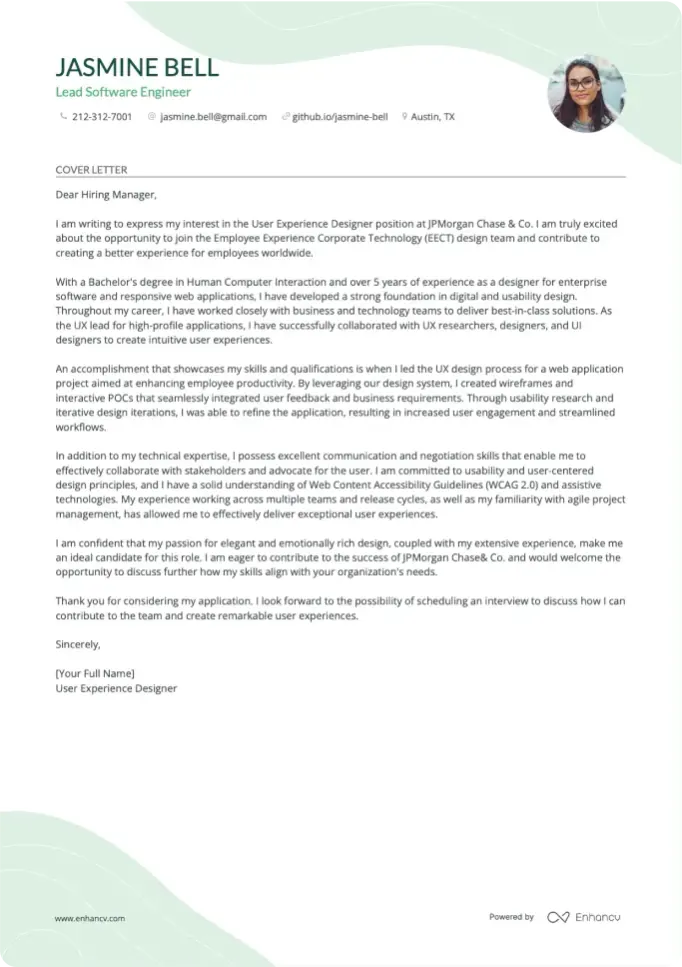Embarking on your job-hunting journey, you've likely realized the need for a standout fine artist cover letter—one that doesn't just echo your resume but brings it to life. Telling the story behind your proudest professional achievement can captivate a hiring manager's attention without leaning on worn-out phrases. Crafting this one-page introduction formal yet personal sets the stage for your artistry to shine, ensuring your first impression is as compelling as your portfolio.
- Making excellent use of job-winning real-life professional cover letters;
- Writing the first paragraphs of your fine artist cover letter to get attention and connect with the recruiters - immediately;
- Single out your most noteworthy achievement (even if it's outside your career);
- Get a better understanding of what you must include in your fine artist cover letter to land the job.
Let the power of Enhancv's AI work for you: create your fine artist cover letter by uploading your resume.
If the fine artist isn't exactly the one you're looking for we have a plethora of cover letter examples for jobs like this one:
- Fine Artist resume guide and example
- Creative Producer cover letter example
- Artist Manager cover letter example
- Photographer Assistant cover letter example
- Background Actor cover letter example
- Commercial Actor cover letter example
- Production Assistant cover letter example
- Model cover letter example
- Performing Arts cover letter example
- Dance cover letter example
- Cinematographer cover letter example
Fine Artist cover letter example
Charlotte May
Undefined, Undefined
+1-(234)-555-1234
help@enhancv.com
- Emphasizing specific past experiences relevant to the role, such as leading the conception and execution of a city landmark sculpture, highlights the applicant's capability and experience in large-scale art projects.
- Detailing the impact of past projects on community engagement and revenue generation demonstrates the candidate's success in creating work that provides both cultural and commercial value.
- Including references to effective team management and cross-functional collaboration shows the candidate's leadership skills and ability to work with diverse groups, which is crucial for large artistic endeavors.
- Expressing enthusiasm for the company’s projects aligns the candidate’s passions and energies with the company's mission, indicating a good fit culturally and professionally.
What are the basics of the design or format of your fine artist cover letter?
To start, here's a reminder for you: the Applicant Tracker System (or software that is used to assess candidate profiles), won't be reading your fine artist cover letter.
Recruiters enjoy reading fine artist cover letters with a standardized format that uses:
- the same font as the resume (e.g. modern ones like Raleway or Volkhov are prefered over the clichéd Times New Roman or Arial);
- single spacing to keep the content concise and organized (this is all ready for you in our cover letter templates);
- a one-inch margin to wrap around the text, like in our cover letter builder;
- PDF as a file format, as it allows your design (and visual element) to stay the same.
Finally, we can't go on without mentioning the key sections of your fine artist cover letter.
In the top one-third, make sure to include a header (with your contact information, name, role, and date), a salutation, and an introduction.
Next, follows the heart and soul of your fine artist cover letter or its body.
End your fine artist cover letter with a closing paragraph and, if you wish, a signature.
The top sections on a fine artist cover letter
Header with Contact Information: This section is crucial for ensuring the recruiter knows who you are and how to contact you; it includes your name, address, phone number, email address, and the date, as well as the recipient's contact information.
Artistic Intent/Personal Brand Statement: Unique to fine artists, this section should introduce your artistic philosophy or overarching vision, captivating the recruiter's interest and differentiating you from other candidates.
Portfolio Highlights: In this section of the body, reference specific works or collections that demonstrate your skills and successes as a fine artist, providing context and relevance to the position you're applying for.
Artistic Achievements and Exhibitions: A portion of the body should be dedicated to outlining your most notable exhibitions, awards, or recognitions, showcasing your credibility and experience in the art world.
Creative Conclusion and Call to Action: Your closing paragraph should reflect your passion for art and express your enthusiasm for the potential of contributing to the gallery or institution, ending with a proactive call to action, such as a request for an interview or portfolio review.
Key qualities recruiters search for in a candidate’s cover letter
Strong Artistic Vision: Recruiters look for artists who have a clear and unique artistic vision, as it sets the tone for their work and enables them to create distinctive pieces that stand out in the art world.
Technical Skill and Craftsmanship: Mastery of various artistic techniques and mediums is crucial, as it demonstrates an artist's ability to effectively bring their creative visions to life.
Exhibition History: A track record of exhibitions, both solo and group, is often seen as evidence of an artist's experience, peer recognition, and the ability to engage with the art community and market.
Artistic Education and Training: Formal education or training in the arts can be a testament to an artist's dedication to their craft and understanding of art history, theory, and practical skills.
Awards and Grants: Recognition through awards, grants, or fellowships can indicate artistic merit and endorsement from respected institutions or industry experts.
Strong Portfolio: A well-curated portfolio showcasing the artist's best work is essential to demonstrate their style, range, and evolution over time.
How to start your fine artist cover letter: with a greeting, of course
Have you ever considered just how powerful a personalized salutation can be?
We sure have news for you! Your fine artist cover letter should start with the right salutation to recruiters, nurturing a sense of respect and individuality.
Greet recruiters by using their first name (e.g. "Dear Tom" or "Dear Patricia") if you've previously established contact with them.
Otherwise, opt out for the less familiar, "Dear Ms. Peaches" or "Dear Ms Kelsey", if you've found the recruiter's name on LinkedIn or a corporate website.
"To whom it may concern" is never a good option, as it creates a sense that you've been sending out your fine artist cover letter to anyone. Instead, use "Dear HR team" or "Dear (company name) recruiter" for a feeling of exclusivity.
List of salutations you can use
- Dear Hiring Manager,
- Dear [Gallery or Museum Name] Team,
- Dear [Last Name of the Contact Person],
- Dear [First Name and Last Name of the Contact Person],
- Dear [Job Title or Department],
- Dear Selection Committee,
The fine artist cover letter intro: aligning your interest with the company culture
You only have one chance at making a memorable first impression on recruiters with your fine artist cover letter.
Structure your introduction to be precise and to include no more than two sentences.
Here are some ideas on how to write a job-winning fine artist cover letter introduction:
- get creative - show off your personality from the get-go (if this aligns with the company culture);
- focus on your motivation - be specific when you say what gets you excited about this opportunity.
What to write in the body of your fine artist cover letter
Now that you've got your intro covered, here comes the heart and soul of your fine artist cover letter.
It's time to write the middle or body paragraphs. This is the space where you talk about your relevant talent in terms of hard skills (or technologies) and soft (or people and communication) skills.
Keep in mind that the cover letter has a different purpose from your fine artist resume.
Yes, you still have to be able to show recruiters what makes your experience unique (and applicable) to the role.
But, instead of just listing skills, aim to tell a story of your one, greatest accomplishment.
Select your achievement that:
- covers job-crucial skills;
- can be measured with tangible metrics;
- shows you in the best light.
Use the next three to six paragraphs to detail what this success has taught you, and also to sell your profile.
Thinking about the closing paragraph of your fine artist cover letter
Before your signature, you have extra space to close off your fine artist cover letter.
Use it to either make a promise or look to the future.
Remind recruiters how invaluable of a candidate you are by showing what you plan to achieve in the role.
Also, note your availability for a potential next meeting (in person or over the telephone).
By showing recruiters that you're thinking about the future, you'd come off as both interested in the opportunity and responsible.
Addressing limited to no experience in the fine artist cover letter
There's nothing to worry about if you lack professional experience.
Your fine artist cover letter could bridge the gaps in your professional history by focusing on what matters most to recruiters, that's either:
- skills - focusing on transferable ones you've gained, thanks to your life experience (e.g. volunteering, certificates, etc.);
- achievements - select the most relevant and noteworthy one from your history (e.g. education, projects, etc.);
- motivation - describe how you envision your professional growth in the next up to five years, thanks to this opportunity.
Key takeaways
Writing your fine artist cover letter has never been easier, so remember to:
- Select a fine artist cover letter template that automatically meets industry formatting (e.g. has one-inch margins, is single-spaced, is in PDF, etc.);
- Make your fine artist cover letter personal by mentioning the recruiters' first or last name;
- Within the introduction, describe what you like best about the company in no more than two sentences;
- Use your fine artist cover letter body to tell a story of your greatest achievement, backed up by job-relevant skills and technologies;
- If you have no professional experience, be honest about it in your fine artist cover letter, but also write about your unique talents.




